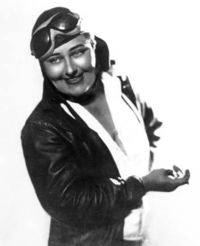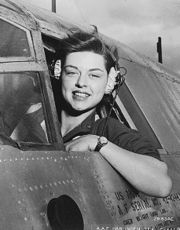Support
You Fly, Girl
<


|
"All those who see me, and all who believe in me, share in the freedom I feel when I fly."
Interview: Bette Bach Fineman
| Bette Bach Fineman was married to aviator/writer Richard Bach (Jonathan Livingston Seagull) for 14 years. In that time she was wife, mother, editor... and co-pilot, until finally getting an Aeronca Champion to pilot on her own.
After their divorce, Bette discovered that she flew not just because her husband did, but because she loved flying. It had always meant freedom.
"The transition back to real life was always hard. In the air, it was just me and the sky and the little plane trying to be safe. On the ground I was Mom, purveyor of groceries, postage stamps, breakfast, lunch and dinner for a home-working freelance writer/flight instructor and five other little people. The constant battle to juggle the required activities of a busy family was represented by a pair of sad shoes sitting on the seat of the car. Only then did I realize the value of the sky, and being in it, if for only a few hours a week."
|
Patterns: Tales of Flying and of Life, Bette Bach Fineman, 2007 |
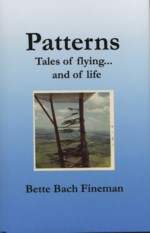
Available from BetteBachFineman.com
|
| Your father worked at Douglas Aircraft. What did he do there?
|
He was a planner. His job was to take the blueprint of the aircraft, assign parts to be made by one department or the other, and all scheduled to come together in sequence to produce the finished airplane.
Right after WWII, I was 8, and he pulled me out of school one day. He took me to another school where he was teaching young war vets how to read blueprints. He gave
me a ruler and announced in a very exasperated voice..."and this little girl will be teaching
you how to read a ruler..." apparently they just didn't get the basics!
|
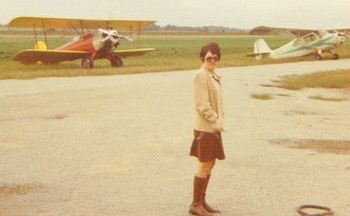
"In front of my "new" first Champ before we repainted it, and our 1929 Parks biplane, focus of the books Nothing By Chance and Biplane by Richard Bach."
|
| When and how did you first meet your first husband, Ricahrd Bach?
|
I was only 15 (in 1954) as a High School Junior at Wilson High School in Long Beach, CA., always involved with music in some way, a capella choir, voice class, etc., and had a crush on Allen Spencer, a fellow singer, for 2 years. When he
actually called me for a date in the summer before my Senior year, I was shocked, but he was just
asking me to be a double date for his friend, and Allen was taking out another girl I knew.
I said yes, just to be able to watch my "first love" with that other girl. The guy he wanted me to date had just graduated and was the class nerd, editor of the school magazine; I had to look him up in the yearbook. Turns out it was the last "date" I ever had, because I hung out
with Richard Bach from then on, and by the time I was graduating at age 16 in June 1955,
we were engaged.
I worked for his father who headed the local chapter of the American Red Cross
for 2 years, eventually running my department (First Aid & Water Safety) at age 18.
They got married in October, 1957 and had six children:
Kristel Luise, (1958) Robert Allen, (1961), Erika Lynn, (1964), James Marcus, (1966) Jonathan Stuart, (1968) and Bethany Jeanne, (1969), before divorcing in 1971.
|
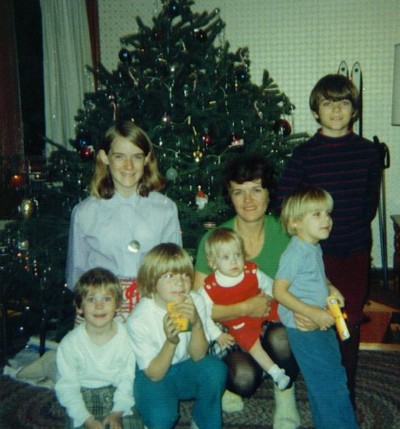
The Bach family, 1970
|
| You were an Air Force wife for many years of your marriage. What was life like as an Air Force wife in the 60s?
|
We were urged to buy a book called The Air Force Wife which included protocol with higher
ranking officers' wives, how to act on the air base, fashion tips, bridge-playing, places on the air
base NOT to go, etc. Generally what was expected of us.
Since people were constantly coming and
going, being transferred, etc., it was hard to make friends. As a new mother, I hung out with
another mother who gave me tips on babies and such. And since Richard became such a bad bridge
player, we weren't invited to bridge parties, so we started our own group who played cutthroat
Monopoly or sometimes pinochle. But I remember going right onto the flight line and looking
at the airplanes, since Richard was an officer with a security clearance. |
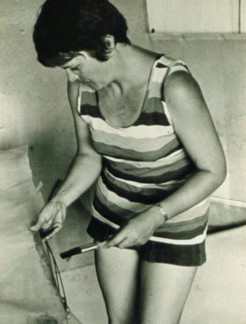
"1971: in the restoration shop working on fabric."
|
| You had been the "support system" for your husband Richard Bach while he wrote his books.
|
I was a good speller and careful reader, able to spot mistakes. Since I flew with him
in small airplanes, I could catch any aeronautical mistake he might make, but very few of those
occurred.
He often would make assumptions that the reader wouldn't know about. Mostly it was over-writing, flowery and poetic and too long. The problem he has today. I would read the article and he would ask "did I like it?" I would say "Yes" or "Not particularly" And he would ask why. Then I would have to delve into why, and by doing that for years, became aware of rough places, repetitive places, boring places, events out of sequence, and other editing problems. I was a good typist and did all the finish work to be submitted to magazines. Mostly I was an ideas person.
|
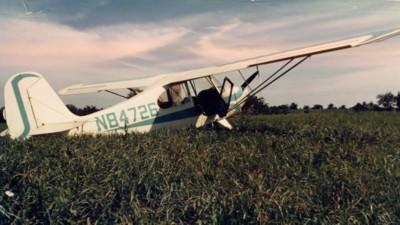
Bette's Champion, 1968 |
| You flew as co-pilot for many years, "passenger and sometime navigator" while Richard
flew...then he took photos for aviation magazines while you flew the plane from the right seat.
|
One of the natural things that happens with two people in the airplane is the other person
tries the controls. I did fairly well, fairly quickly. He was a fair pilot, but an excellent
instructor.
As an editor for Flying Magazine, he took cover photos from time to time and we had an airplane then with a roll-down window which he hung out of. So I learned how to fly close to another airplane. But I had no desire to fly alone.
|
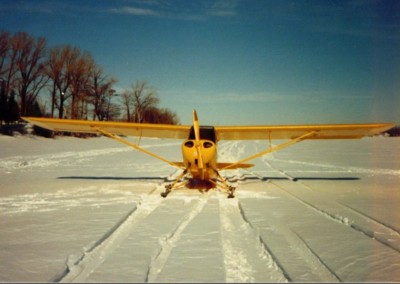
"A shot of my second Champ in about 1993, on skis."
|
| You met Ernest K. Gann. Did you share all your anecdotes about him, or are there any more to
tell?
|
He was the ultimate gentleman, sharing his appointment with Richard with me in the room where he wrote his books. We toured his main living room which had intricate models of each boat he had owned, all in large glass display boxes. He was very proud of his prize breeding bull, out in the corral. I think I met Dodie, his wife, briefly, but she was used to being gracious, then disappearing so Ernie could be the star. I learned from her actions, and when Richard got more well-known, did the
same with our visitors.
|
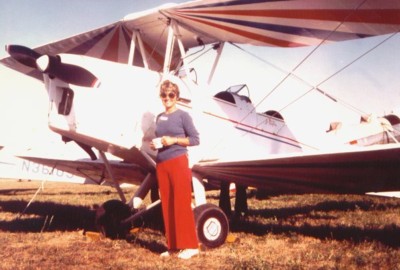
Bette and her Tiger Moth
|
| You spent an evening with Lloyd Stearman, Benny Howard and Pancho Barnes. Can you share any anecdotes about Pancho Barnes?
|
As for Lloyd Stearman
and Benny, they were on either side of me, talking across me, and ALL about airplanes. Pancho
talked a lot, but mostly swear words, and nothing about flying. I was not a pilot, hadn't flown
much and was just a spectator. I would love to have that night back, to make the most of it!
|
| Today, it seems that about 6% of all pilots are female. Was that the same ratio then, do you think?
|
The ratio was much less back in the sixties. The female pilot stood out as a freak almost
like Pancho did, and others, "uppity women" trying to prove something.
In the forties, the advent of the WASP created so many women in aviation that I am amazed when
the war ended, most of them just disappeared. Numbers were slow to grow. In the late sixties and
seventies, many more women were flying and I befriended a gal named Tracy Pilurs, who not only flew, she built her own biplane. This was getting more common.
I joined the Ninety Nines in 1972 and met lots of active women pilots. By the eighties, women
were everywhere in aviation, even the airlines.
|
| How'd you learn to plot a course? What are the mechanics of it? What is taught in a "ground
school" course?
|
Sitting in an airplane with a chart on your lap, you learn how to compare the map with
the ground..situational awareness they call it now.
Charts come in two scales, a WAC chart
gives you lots of area, less detail. Good to use if you have an airplane with lots of range
and higher speed. The Sectional Chart is detailed down even to the shape of a lake, roads, radio
antennas, some buildings, airports of course, ground elevations, commercial airway markings,
radio frequencies. All in different colors you get to know what they mean (midwest ground is
depicted in greens, higher elevations like Colorado, are browns.)
You have a "plotter" with
the same scale as the chart, and can draw lines for a course and know how many miles you have
to travel to your next checkpoint. The time traveled on that course depends on the air in
which you move.
Picture a goldfish in a bowl... the fish swims at a certain speed (in an
airplane, that is the airspeed), now you walk with the bowl. The water in the bowl is now
moving. The fish still swims at the same speed, but his groundspeed has changed. You have to know
what the wind is doing if you want to estimate your arrival time.
Ground school also covers weather (recognizing weather conditions, plus reading official
aviation weather reports), navigation using a chart and/or radio aids, including GPS now,
FAA regulations, internal combustion engine operations, use of instruments.
|
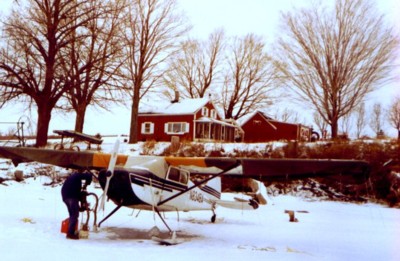
"Jon's Cessna 170 on the ice of Lake Champlain in front of our vintage Alburg, VT home. 1979."
|
| You spend 4 years learning how to fix your Champ (severely damaged in a windstorm), learning the skills by visiting aircraft
owners at the EAA fly-in in Oshkosh. What sort of skills in particular did you learn.
|
Oshkosh was a wonderful place then, still is, just so much bigger it takes the fun away.
They had small tents where experts demonstrated how to build and repair things. I attended the
woodworking booth to learn how to splice a wing spar. The next year I worked at one of the
fabric booths (applying new fabric on my Aeronca tail I brought with me, and learning how to
patch a tear or scrape) and later the paint booth. For the spar, they had sample wood pieces to work on.
For the fabric, someone produced an airplane needing cover and people just worked on it. For paint,
various pieces of airplane, junk mostly, were used. It was the techniques being taught.
|
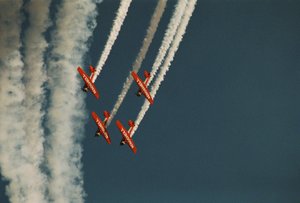
(Wikipedia, PD photo)
Osh Kosh Air Show, 2004
A far cry from the shows Bette used to attend!
|
| You moved to Newburyport to work for Kensington Aircraft. What year was this, and what did you do there?
|
1972. I had gone there first in 1971
to pick up my biplane, but it wasn't done, so I had to join the crew and work on it. Then flew
back there in 1972 for its annual inspection and they asked me to work for them. We moved in
1973 and I did things like paint masking, hand lettering on museum-quality restorations,
part washing, using my small arms to fit inside places where the guys could not reach, paint
stripping, sorting parts received from places like North Africa and New Zealand. I also answered
the telephone, got the coffee, took the lunch orders, drove out to get supplies, etc. I had tried
using most of the general tools, but my hands were too small to be effective.
|
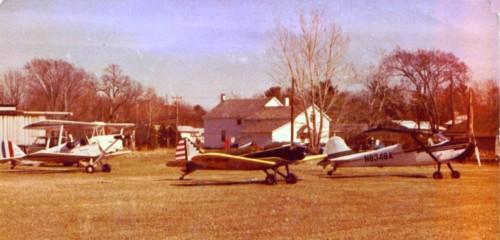
"Our newly-combined fleet of planes taken in 1979 (the Tiger Moth, a Fly-Baby and a Cessna 170)"
|
| Can you share some intricacies in flying the Tiger Moth as opposed to the Champ? (Bette flew an Aeronca Champ for many years, than acquired a DeHavilland Tiger Moth. (Most famous as a British biplane used during WWII, but built in Canada and Australia well after that. Hers was new in 1944.)
|
A whole new ballgame. A bicycle and a motorcycle. Open cockpit, flown from the back
seat instead of the front as the Champ is, with wings and struts all in the way of your
view of the runway. An inverted engine, which means the prop turns the opposite way, so
the torque on takeoff is different, but you get used to it. The lower wing panel so
close to the ground you can't make a crosswind landing with any assurance
Cold. Wind.
Oil everywhere. Metric parts, British Standard parts, U.S. parts... a nightmare to maintain.
More fun, and more pride, than anything I ever did.
|
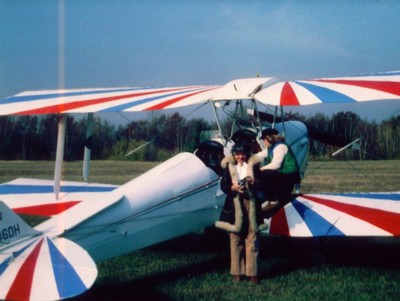
Bette and Erika and her Tiger Moth
|
| You attended a convention at Blakesburg, IA. Did you fly anyone else's planes, and let them fly yours? Were there any other
women pilots there?
|
I flew in several other airplanes, but not solo. I had enough responsibility without
risking someone else's pride and joy! No one flew mine. It was unusual enough that it would
not be prudent, no matter how good I thought the other pilot was.
There were four other Tigers
at that fly-in and those four guys were very impressed with themselves. When I showed up they
were not friendly, and they waited to have their four-ship formation flight when I had left
to go somewhere else, rather than have me in the group. They had no idea I was a trained
formation pilot, and they were being cautious, I suppose.
Since I had flown from the east
coast, I thought sure I would win the distance trophy, however, a lady flew from California
and took it. Only she had flown in formation with her husband and didn't have to navigate.
There was a lady in a Champ from Canada, I remember, and maybe one or two others.
|
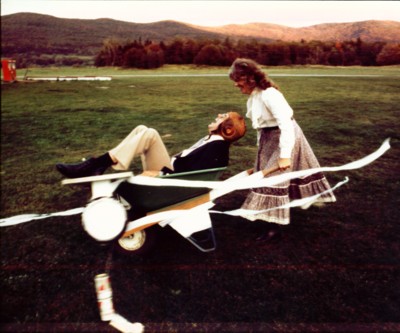
1978: Jon Fineman and Bette Bach wedding day
"Me pushing Jon in a wheelbarrow which was made into an airplane."
|
| In chapter 13 you share your adventures with June.
|
She was a sailplane instructor and had taken over the office when the last manager
left, it included schedule of scenic flights, instruction, tow plane ops and fuel sales,
and she needed some help, so I joined her in the effort.
The Glider Club owned the gliders
and ran the flight line and paid the glider pilots, but we paid the tow pilot. I designed
a tee-shirt, organized some other stuff for sale as extra income, kept the schedule and the
books, answered the phone, collected money, ordered the fuel. She continued to instruct.
I got my glider rating in a Schweitzer 2-33. [An] odd footnote, June and I still hold the "Female Multi-Place" glider altitude record for the State of Vermont. We froze our toes getting to 10,500' in October and had to come down when we hit a snowstorm!
|
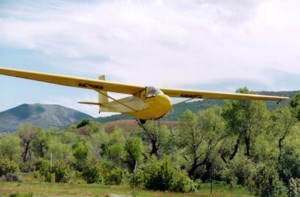
Photo courtesy Dale Taylor
A Schwietzer 2-33 glider |
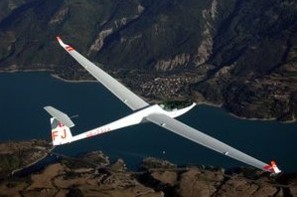
Wikipedia, PD photo.
A high performance sailplane
|
| Please share some insights in what it's like to pilot a glider.
|
It's like getting into a little cocoon only with a plexiglass dome over you. A hooker
hooks you up to the tow plane and lifts one wing to level, when you are ready you give the
signal and the tow plane hits the throttle. As soon as you start moving you are flying, a
few inches off the ground, even before the tow plane lifts off. All is quiet but for the
wind sounds.
You stay a bit above the tow plane to get out of his wake, get to several
thousand feet above the ground and while in a turn release the rope, make an immediate turn
out and the tow plane feels the release and turns in and is gone.
From there you enjoy the
view, monitor your airspeed and variometer which measures lift, and you stay in lift as
long as you can. At a certain altitude you make the decision to go home and glide all
the way, using spoilers that rise out of the wing to adjust your speed in the pattern in
order to brush lightly on the grass near the end of the runway.
A totally impractical way
to fly!
|

Photo courtesy Dale Taylor.
Panel of a Schweitzer 2-33. |
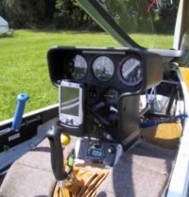
Wikipedia, PD photo.
Instrument panel, high-tech glider.
|
| More on gliders.
|
The 2-33 is quite common at glider schools. Smaller wingspan, easier to park wing to wing, tough enough to take student abuse. The sleek high-performance gliders are usually called sailplanes, because they can get higher and go faster to break records, they have water ballast that can be dumped in an emergency or for other reasons, and are taken apart almost each time they are done flying for the day.
Schweitzer types, especially the trainers, are heavy and mostly just glide, which makes our record more important to June and me. My son Rob the airline pilot soloed a glider when he was 14 and was so small that he had to carry a lead-weighted pillow in the other seat. He stayed up when everyone was down with no lift, and they called him Chicken Hawk. That may be where he got the chutzpah to fly better than them all.
|
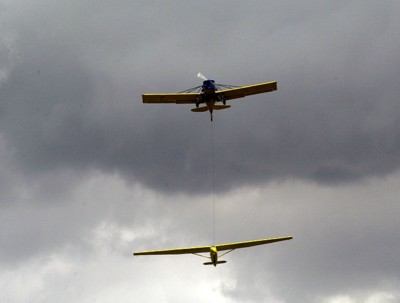
Photo courtesy Dale Taylor.
Schwietzer on tow.
Visit Dale's site SoarWest.com
|
| You and new husband Jon Fineman founded Northern Lights Airfield, Alburg, VT.
|
We built the airfield, but others would stop by and want to learn to fly. They would
buy an airplane, learn to fly, then keep it there, so we had to build more hangars. We worked
on the airplanes we had, but no real restoration, just upkeep.
Take a look at www.scootair.org
You can see the first small red hangar, the gray ones we built, and what the next owner has
done. He even bought the property next door for a fly-in B&B: www.northernlightsvermont.com.
|
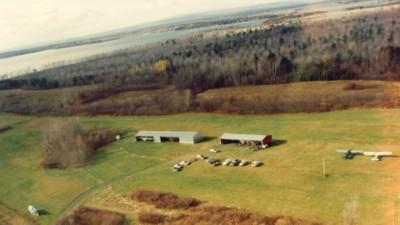
Northern Lights Airfield 1984
|
| You tried for various trophies. Did you enjoy that type of competition?
|
I won several, actually. One for best biplane (I was the only biplane). One for spot
landing in the Tiger Moth. (An accident, as I didn't know they were having a contest.) One for
best Tiger Moth. (I was the only Tiger Moth) and in recent years, Best Aeronca Champ at the
Cactus Fly In in Arizona, twice. Personally, I won Antiquer of the Year, in Iowa. I am not
one for trophies, but it is fun now-and-then to have a pretty airplane that wins something.
|
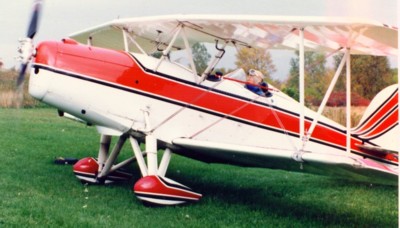
Jon Fineman in a Great Lakes trainer
|
| On occasion, you picked up and delivered planes for other pilots.
|
I would have to consult my log to count. 6 or 8 is all. Aeroncas, Cessnas, a Cub, an
American Champion, one biplane (Great Lakes).
One little moment at an air show always makes me smile. I was in my flying garb, standing in front of the Tiger Moth explaining how it flies, when a little boy walks up and
Says “Boy, you must have a lot of money to fly this airplane..” My only answer was
“I would have a lot of money if I DIDN’T have this airplane.”
|
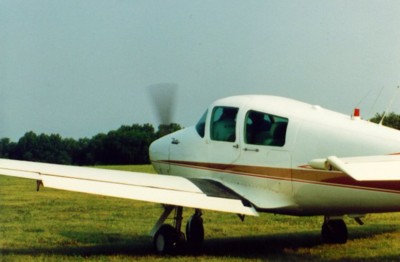
"Our Big Iron we had for about 8 years, a Navion Rangemaster, sold in 1992."
|
| You know a few WASP. Do you find that people these days know who the WASP were, and appreciate what they accomplished?
|
No, people don't remember what they did, a shame. People don't know how many died
doing it, either. Our local WASP are Nell Bright and Beverly Wilkinson. I have never
been to the museum, but seen pictures. They have wonderful stories.
|
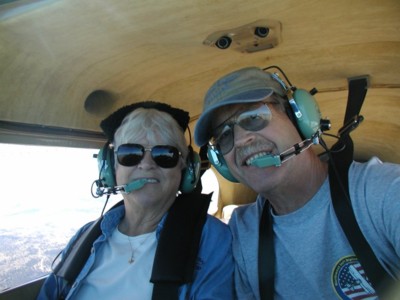
"The Flying Finemans as they look today in flight."
|
| Are there any issues you'd like to address, that I didn't in my questions?
|
I have had comments about my "neglecting my children"
but I still feel that I had to do certain things to survive and stay mentally centered in the face
of extreme depression [covered more fully in her memoir: Patterns.]
If my kids suffer now, it is because they lost their father, and yearn for his approval of their lives. They want their kids to know who he is/was. A simple enough thing, seems to me. A good step-father is a great thing to have, and they appreciate him, but he is not their dad.
The only other issue is that women have to be people first, and mothers second.
|
To read more about the adventures of Bette Bach Fineman, check out her memoirs!
|
|







